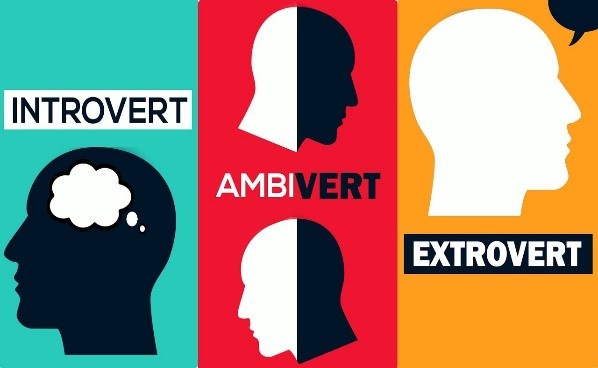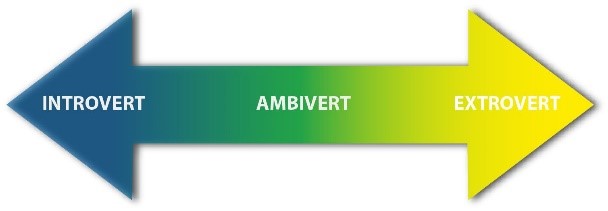
I am neither an extrovert nor an introvert. If you asked some of my acquaintances who only vaguely know me they would probably say that I am quite introverted, as I tend to be quite quiet and withdrawn, especially in unfamiliar social situations. Others, who know me more well, would say I am extroverted, as I’m more confident around these people, to an extent where I feel comfortable being quite open and honest. Interestingly, dictionaries have a word for people like me – ambivert. You might have also seen people who are in between the two extremes referred to as ‘omniverts’. Regardless of the terminology, this is someone who displays classic traits of both introverts and extroverts, in specific situations.
From my perspective, being autistic makes me more susceptible to ambiversion. The way my energy and emotional capacity works is I can be extremely sociable and outgoing one moment, while in the next I can be extremely socially conscious, awkward and demanding to be on my own. Similarly, if I’m secluded for too long, I get bored quickly, and agitated with my own company. It’s a mixed blessing as being an ambivert means I can enjoy being both social and alone, but I can never be truly comfortable for longer than the set amount of time which my mind allows me to be content. Its not just social occasions; in work I can be enthusiastic or full of ideas one moment, but after I’ve finished or while I’m on a break, I will be quiet, recuperating using music or a book and – as someone on the spectrum – less responsive to social cues, finding interaction far more difficult.
Some people plot these contrasting states on a continuum with ‘introversion’ and ‘extroversion’ at either end, which is accurate. However, I like to think of my mental states as more of a rechargeable battery. I stop short of saying ‘one which determines the effectiveness of the item its powering’ because that would be taking the metaphor to a ridiculous extent and would appear to imply that I’m at my least effective when I’m having a ‘down’ or introverted moment, when in reality I’m simply being me under different circumstances. Lastly, keep in mind that all these labels are completely arbitrary concepts, and you can never entirely accurately categorise someone as an extrovert or an introvert, as humans don’t fit comfortably into categories.
The definition of ‘Ambivert’ is abstract but useful…
I’m sure you’ve been asked plenty of times whether you’re an introverted or extroverted person. And when you were asked that there’s a significant chance you responded based on your experiences of being around people and how you feel in those situations. For this reason, the introvert/extrovert dichotomy is something of a misnomer and reflects an outdated view of personality. Bradberry, writing in Forbes defines personality as ‘a stable set of preferences and tendencies through which we approach the world’. For autistic people certain elements of social awkwardness or changeable reactions may effect how people judge us. And, to harp on an oft repeated talking point, what about masking? If you’ve ever been in a social situation where you’ve had to live up to the assumed definition of being extroverted i.e confident and outgoing, even while your anxiety is eating you inside, then you will begin to see the dichotomy as quite limited. Adam Grant set out to study this distinction. He found that two-thirds of people don’t strongly identify as introverts or extroverts. These people are called ambiverts, who have both introverted and extroverted tendencies. The direction ambiverts lean towards varies greatly, depending on the situation.

Some people can confuse some autistic peoples shyness and social anxiety for introversion. Likewise, if an autistic person spends hours talking about their special interest fluently and confidently with people who are in their immediate social circle, they might be perceived as quite extroverted. But these perceptions might not reflect how the person in question see’s themselves. A person who identifies as an introvert might enjoy social interaction in small doses. Similarly, a person who identifies as an extrovert might enjoy being on their own in certain situations, for instance if their upset. This is why I like the term ‘ambivert’ – it gives a sensible third point with which to understand the states of introvert vs. extrovert as more opposite ends of a continuum, rather than a case of ‘your either one or the other’. But…hang on… if most people drift around in the middle of the spectrum drifting from one side to the other depending on circumstances, why do we need definitions? Can’t we just discard the entire concept? Well, we could, but I have been a bit popularist in defining my terms so far. Looking deeper provides a blueprint for how we might usefully understand and apply them…
How you recharge is important…
The idea of introversion and extroversion first came from Swiss psychiatrist Carl G. Jung in the early 1900s. He believed that extroverts were energized by the external wold and that introverts were energized by the internal world. He thought that extroverts direct their energy towards the world around them and gain energy from things like interactions. Introverts, meanwhile, focus their energy inwards, towards more solitary activities. This is still very oversimplified but as explained in the introduction with the battery analogy, I find the idea of ‘social energy’ quite useful. Indeed, in line with my definition for myself as an ambivert, both the internal and external world can build up or sap my energy.

Returning to the battery analogy for a second, I think there is potentially more to it than ‘I need to recharge after doing the same thing for too long’. If my battery is full and firing on all cylinders for too long I can become restless, anxious and often very emotional in a short space of time. If it’s empty for too long I will become distanced from my situation, unable to focus on what people are saying or start staring off into space. I both desperately need other people and desperately need to be alone at different times. Often when I’m at social gatherings, and there’s three or four groups each containing people that I know, I will wander between groups as different forms of communication affect me in different ways. As an autistic ambivert, regulating small elements such as how I communicate and the environment I’m in, is something I need to do as a coping mechanism. Lockdown has left many of us absent of those sorts of choices. I must admit that without tools such as the internet which allows me to watch a concert or talk to friends, I would feel even more isolated and unable to flick between different mental states. I think that while terms like ‘ambivert’ might be reductionist, they are useful tools in understanding how many people – particularly autistic people – interact with the world around them.
Regulating sensory environments is key to being an ambivert…

Perhaps this should read “regulating sensory environments and internal states of being…”. I mentioned masking earlier in this blog post, and I feel its important to note that someone who appears withdrawn at a social gatherings might have good reason to be that way in the moment. Constantly being ‘on’ and required to live up to some expectation of how you should behave in that situation is not possible for everyone. One article I read doing research for this blog post said that: ‘a self-aware ambivert will lean toward the extroverted side of the scale, even when it has been a long day and he or she has had enough of people’ and while there is a grain of truth in this statement, it immediately follows the sentence up with ‘Mismatching your approach to the situation can be frustrating, ineffective, and demoralizing for ambiverts’ with no acknowledgement of how frustrating camouflaging can be.
This is why a healthy approach to regulating ones environment is needed. Its why I like having the option to be around people or on my own when I’m working. Its why I often block out busy environments by listening to music. Its why when I’ve been on my own all day, I find meeting up with a friend to be incredibly energising. Like I was saying earlier, circumstances are key, and so is having the flexibility to put myself in different environments when I feel the need to. This is quite often difficult and involves lots of planning ahead, so for example if I know I have a busy week ahead of me, I will often need to plan time to wind down the following weekend. Equally, being an ambivert requires learning to say ‘no’ when necessary. Its easy to become swept up in obligations, just as its easy to become caught up in not wanting to do anything in which case you need to tell yourself ‘no’. Its an odd and occasionally uncomfortable process of self-evaluation which can be tiring in itself, yet also liberating and positive.
An Atypical Perspective
I hope through reading this blog post you have come to a greater understanding of why questions around confidence and introversion vs. extroversion matter. The terminology of ‘ambivert’ is a useful if flawed way of understanding how many autistic people interact, and the struggles we go through to maintain a mentally healthy balance of being around people and being on our own. I feel as if there’s a presumption outside of the autistic community that we can’t socially interact and that our erratic behaviours are testament to our inability to communicate and understand people properly. This is disrespectful as many autistic people are tying to do just that – true, we ned to be on our own sometimes and our emotional states can be volatile and changeable. However, it’s not through an inability to enjoy and savour the experiences that we struggle, but through huge efforts to members of society while simultaneously cherishing our individuality as autistics.
Reblogged this on Autism Candles.
LikeLike